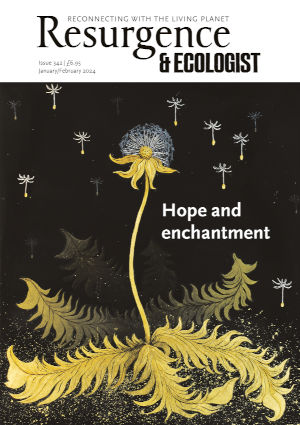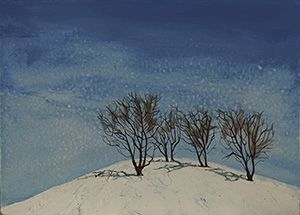This anthology is described as “A treasure trove of Nature tales from storytellers across the globe, bringing a little magic and wonder to every winter night.” I’m accustomed to froth in the marketing of books, but rarely do I think that the description has undersold the words. This isn’t a fun, whimsical collection of fireside yarns – it is far deeper and more poignant than that.
Nancy Campbell is expert at taking winter’s chill and pla-cing it under the microscope of her own creativity. As a poet and nonfiction writer, she has written about the polar environment ever since spending a winter as artist-in-residence at the most northern museum in the world, on Upernavik, in Greenland, in 2010. Her work is always intelligent and goes beyond the superficial, whether she is analysing specific types of snowflake in Fifty Words for Snow, or exploring what home really means while living in a caravan in her memoir Thunderstone: Finding Shelter from the Storm, to mention just two of her books.
As the editor of Nature Tales for Winter Nights, which shares winter-themed words from around the globe, Campbell brings the scientific precision that allows her to make forensic choices, alongside a deep emotional connection with and understanding of the interaction between people and Nature. The result is rich, multi-layered and deeply meaningful.
This anthology is wide-ranging in every way. The geographical scope is global, with an emphasis on the northern hemisphere, and it encompasses rural, wild and urban settings. It spans history and diverse cultures, with tales expressed through many forms, including fiction, diary, poetry, formal records and private letters. This ambitious, omnivorous menu could feel disjointed, but the editorial acumen makes it a smooth and flowing read.
Campbell lays out her intentions with the very first excerpt. We begin not with a cosy fireside tale, but with an extract from Anne Frank’s diary. The pure shock of Anne’s simple desire for fresh air is visceral, and the short excerpt that might have been overlooked within her whole diary stands out in crystalline, chilling perfection. It is immediately followed by a delightful, amusing account of courtiers at play in the snow to entertain an empress: “I and the other ladies-in-waiting gathered large quantities of snow and heaped it in lids; then we decided to build a real snow mountain in the garden.” Yet this playful story from The Pillow Book of Shōnagon is undercut by Frank’s preceding words. Adults behaving as children have been juxtaposed with a child in danger, hidden in terror and denied such simple fun.
There are familiar names, such as Tove Jansson, John Clare and Charlotte Brontë, whose words in this context are new and startling. This excerpt is from Virginia Woolf’s Orlando: “The Great Frost was, historians tell us, the most severe that has ever visited these islands. Birds froze in mid-air and fell like stones to the ground. […] Corpses froze and could not be drawn from the sheets. It was not an uncommon sight to come upon a whole herd of swine frozen immovable upon the road.” On beginning reading, we don’t know if the descriptions are fiction or non-fiction, literal or metaphorical, which is a destabilising sensation.
The known writers nestle alongside others I would never have discovered, such as the fireside stories told by Indigenous voices, or tales from ancient Rome. The natural world forms a large part of the anthology, but it is the diverse human voices that bring the very experience of winter to life, from the charming to the life-threatening.
Each piece is simply presented without a date or indication of location (unless given as part of the excerpt). This means we are dropped without preamble into anywhere in the world, anywhere in history, and must make of it what we will. What this achieves is a freshness because, for example, Charles Darwin’s words are read initially as removed from him and his historical significance. It also creates a timeless quality that on one occasion, immersed in a world that could not at first be located in history, the mention of a wheelie bin suddenly set me straight. I often sought context and anchoring in the author biographies in the back of the book, somewhat interrupting my flow but always enriching my experience.
An excerpt by Salomon Andrée read like experimental poetry, with a few words scattered here and there, giving a fleeting impression of darkness, ice and sea. When I read the author biography the piece was thrown into sharp relief. These were the fragmentary remains of the diary of an engineer, physicist and aeronaut who attempted to reach the North Pole by hydrogen balloon in the late 19th century. When Andrée’s body was discovered years later, his account was found in his breast pocket, damaged but with some words remaining. I would hate to have missed this information and yet I admire the playful approach of leaving the context removed from the extract. It made reading as active or as passive as I wished.
An anthology should not just be a collection of like-themed pieces, held together maybe by date or location. To be truly successful, the whole story should be far more than the sum of its parts. Campbell has achieved that. Each piece builds, intensifies, adds layers and complexity. Some inform, some amuse, and some break our hearts. Winter is beautiful, winter is cruel, winter is fun, winter is death. The erudite rise and fall guides and immerses the reader. This anthology isn’t twee or cutesy – it is profound, surprising and moving. It will transport you to another place and time and bring a new, nuanced understanding of our coldest season.
Nature Tales for Winter Nights by Nancy Campbell (ed.). Elliott &Thompson, 2023. ISBN: 9781783967421.








